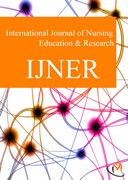Abstract
Title
EFFECTIVENESS OF AN INFORMATION BOOKLET ON KNOWLEDGE AND ATTITUDE OF KSRTC DRIVERS REGARDING RISK FACTORS AND PREVENTION OF DEEP VEIN THROMBOSIS IN SELECTED DEPOTS, RAMANAGARA
Author
Tejeshwari.B.V1, Adarsh B K
Email
tejeshwinirajesh@gmail.com
keyword
Effectiveness,
Knowledge, Attitude,
Information Booklet,
DVT, KSRTC drivers,
Risk factors and
Prevention
Abstract
DVT is a clinically entity with potential risk, as it can lead to pulmonary
embolism. Therefore it needs to be diagnosed as soon as possible, followed by quick
intervention. Deep vein thrombosis refers to the formation of a thrombus, which is a blood
clot that forms deep in the veins, most often in the leg such as the calf veins, femoral veins,
popliteal vein or deep veins of pelvis and even arms. It can partially or completely block
blood flow to the heart and damage the one-way valves in the veins. It can also break free and
travel to major organs such as lungs which can be very dangerous. The affected limbs in
many persons become painful, warm, swollen, and red with engorged superficial veins. It is a
potentially dangerous condition with a myriad of risk factors that can lead to preventable
morbidity and mortality. Prophylaxis is very important and can be mechanical and
pharmacological. The mainstay of treatment is anticoagulant therapy. Low molecular weight
heparin, unfractional heparin and Vitamin K antagonists have been the treatment of choice1.
The exact incidence of DVT has been difficult to know, due to problems in clinical diagnosis
of DVT. Some studies state the incidence of venous thromboembolism is higher in Asian
population compared to western population. In adults, the clinical conditions that predisposes
to DVT are increasing age, cancer and its treatment, prolonged immobility, stroke or
paralysis, congestive heart failure, acute infection, pregnancy, dehydration, long travel, and
rheumatoid disease2. DVT is a major and a common preventable cause of death worldwide. It
affects approximately 0.1% of persons per year. The overall average age and sex adjusted
annual incidence of venous thromboembolism is 117 per 100,000 (DVT, 48 per 100,000, PE,
69 per 100,000) with higher age-adjusted rates among males than females. Men are having
higher risk of recurrent thrombosis3. Objectives: - 1. To assess the pre-test knowledge and
attitude of KSRTC Drivers regarding risk factors and prevention of deep vein thrombosis.2.
To assess the post-test knowledge and attitude of KSRTC Drivers regarding risk factors and
prevention of deep vein thrombosis.3. To evaluate the effectiveness of information booklet on
knowledge regarding risk factors and prevention of deep vein thrombosis among KSRTC
Drivers. 4. To correlate the knowledge and attitude of KSRTC drivers regarding risk factors
and prevention of deep vein thrombosis. 5. To associate the post-test knowledge and attitude
of KSRTC Drivers regarding risk factors and prevention of deep vein thrombosis with their selected demographic variables. Design: - Evaluative research approach was used for the
study. 60 KSRTS drivers were recruited by non probability purposive sampling method.
Necessary administrative permission was obtained from concerned authority.Oral consent
was obtained from all subjects. After the investigator collected the data pertaining to the
demographic variables. After which the data will be collected using structured interview
schedule. Ethical clearance was obtained from Institutional ethical committee. Content
validity of the tool was established by split of method. The obtained score was 0.96 & it was
found to reliable. Pre-testing of the tools was done. Setting: - The study was conducted in
selected depots, Ramanagara. Result: - The findings of the study was revealed that the mean
score of knowledge regarding risk factors and prevention of deep vein thrombosis was 11.6 in
pre-test and 18.3 in post-test out of maximum score of 25. The mean score percentage was
46.4 in pre-test and 73.1 in post-test, which proved that information booklet was effective in
increasing the knowledge level of KSRTC drivers regarding risk factors and prevention of
DVT. The paired„t? test found be statistically significance at 0.05 levels. The Pearson?s
correlation coefficient value r=0.67 which indicates that there is a positive correlation
between knowledge and attitude of KSRTC drivers regarding risk factors and prevention of
DVT. Conclusion: - The present study attempted to assess the effectiveness of information
booklet on knowledge and attitude of KSRTC drivers regarding risk factors and prevention of
DVT and it was found that the information booklet was effective in improving the knowledge
and attitude of KSRTC drivers













